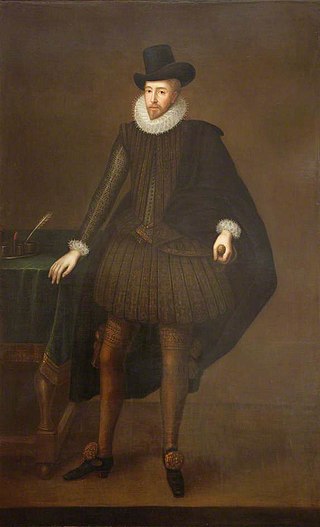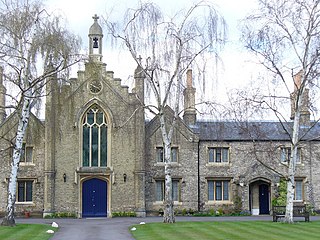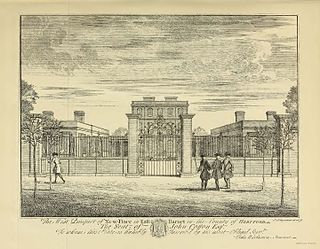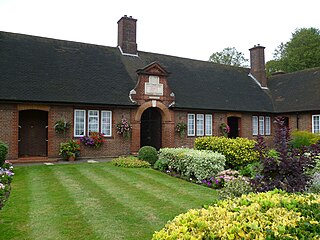




Lancelot Gerald Hasluck (10 November 1861 - 2 July 1937) was an English surveyor and philanthropist who founded the Lancelot Hasluck Trust.





Lancelot Gerald Hasluck (10 November 1861 - 2 July 1937) was an English surveyor and philanthropist who founded the Lancelot Hasluck Trust.
Lancelot Gerald Hasluck was born in Enfield, [2] Middlesex, on 10 November 1861, the younger son of Frederick and Emma Hasluck (née Pedley) of Greenhill Park, Barnet. After his father died in 1887, his mother married the Reverend George Twentyman, the minister of New Barnet Congregational Church, who died in 1912. Emma Hasluck died in 1926. [1]
Frederick Hasluck was in partnership with his brother as merchants in Hatton Garden, London. The Pedleys were lawyers in the City of London and Lancelot's grandfather, Samuel Pedley, had interests in property in London. [1]
Hasluck was a fellow of the Institute of Chartered Surveyors and from 1898 a member of East Barnet Urban District Council. He was a magistrate and a governor of the Queen Elizabeth's School. He was vice-chairman of the Jesus Hospital Charity. [1]
He is best known, however, for the Lancelot Hasluck Trust which provides almshouses to residents of East Barnet, Chipping Barnet or Friern Barnet who are of limited means. Hasluck established the trust on 18 September 1931, originally with the aim of providing housing for married couples when most almshouses were intended for single people. Bombing during the Second World War hindered the development of houses but it now owns 44 properties. [1]
Hasluck died on 2 July 1937. He is buried at Bells Hill Burial Ground, Chipping Barnet. He and his family are remembered in the streets Hasluck Gardens and Greenhill Park in New Barnet, and Lancelot Gardens near Oak Hill Park.

The London Borough of Barnet is a suburban London borough in North London. The borough was formed in 1965 from parts of the ceremonial counties of Middlesex and Hertfordshire. It forms part of Outer London and is the second largest London borough by population with 389,344 inhabitants, also making it the 17th largest district in England. The borough covers an area of 86.74 square kilometres (33 sq mi), the fourth highest of the 32 London boroughs, and has a population density of 45.8 people per hectare, which ranks it 25th.

Lancelot Brown, more commonly known as Capability Brown, was an English gardener and landscape architect, who remains the most famous figure in the history of the English landscape garden style. He is remembered as "the last of the great English 18th-century artists to be accorded his due" and "England's greatest gardener".

Chipping Campden is a market town in the Cotswold district of Gloucestershire, England. It is notable for its terraced High Street, dating from the 14th century to the 17th century.

Chipping Barnet or High Barnet is a suburban market town in north London, forming part of the London Borough of Barnet, England. It is a suburban development built around a 12th-century settlement, and is located 10+1⁄2 miles (17 km) north-northwest of Charing Cross, 3 miles (4.8 km) east from Borehamwood, 5.2 miles (8.4 km) west from Enfield and 3.2 miles (5.1 km) south from Potters Bar. Its population, including its localities East Barnet, New Barnet, Hadley Wood, Monken Hadley, Cockfosters and Arkley, was 47,359 in 2011.

Chipping Barnet is a constituency created in 1974 represented in the House of Commons of the UK Parliament since 2005 by Theresa Villiers of the Conservative Party. Villiers was the Secretary of State for Northern Ireland from 2012 until 2016 under the leadership of Prime Minister David Cameron before she was dismissed when the incoming Prime Minister Theresa May took office. Boris Johnson appointed her as Secretary of State for Environment, Food and Rural Affairs in July 2019 before she was sacked in February 2020. It is part of the London Borough of Barnet.
The London Borough of Barnet, located on the northern periphery of London and having much of the area within its boundaries in the Metropolitan Green Belt, has many parks and open spaces. In addition there are large areas taken over by cemeteries and golf courses, and part of Hampstead Heath.

Arkley is an area of north London, England, within the London Borough of Barnet. It is located 10.6 miles (17.1 km) north-northwest of Charing Cross.

Baptist Hicks, 1st Viscount Campden was an English cloth merchant and politician who sat in the House of Commons between 1621 and 1628. King James I knighted Hicks in 1603 and in 1620 he was created a baronet.

Bells Hill Burial Ground is a cemetery and Site of Local Importance for Nature Conservation in the Parish of Chipping Barnet in the London Borough of Barnet. It was opened in 1895 and closed in 2005 when it officially became full. In 2006 control was passed to Barnet Council. There is access from Spring Close.

Hickey's Almshouses are almshouses between Sheen Road and St Mary's Grove in Richmond, London.
Thomas Brand (senior), was an English country landowner of The Hoo, Kimpton, Hertfordshire and politician who sat in the House of Commons from 1741 to 1770.

Frederick Charles Cass (1824-1896) was the rector of the parish of Monken Hadley in north London. His father, also Frederick Cass, owned the relevant advowson giving the right to make such appointments. He was the author of works of local history relating to South Mimms, Monken Hadley and East Barnet.

Little Grove, originally Danegrove, was a house and estate that once existed in East Barnet on high ground to the south of Cat Hill. The original house on the site dated from at least the mid sixteenth century. In 1719, it was demolished and replaced with a house known as New Place but the house soon returned to the name of Little Grove. That house was demolished in 1932 to make way for a housing development.

Eleanor Palmer was an English philanthropist who established a charity to help the poor of Chipping Barnet and Kentish Town, now parts of London. Her charity still exists and owns and runs almshouses and residential homes for the elderly.
John Foster, was an English architect and partner in the architectural practice of Foster & Wood of Park Street, Bristol who designed a number of well known buildings erected in Bristol in the 19th century. "It must sometimes seem that the whole of 19th-century Bristol, or at least all of its significant buildings, owed their design to the firm of Foster and Wood".

Willenhall House was a house and estate located to the south of Chipping Barnet, on the borders of Hertfordshire and Middlesex, in what is now north London. It was designed by John Buonarotti Papworth in 1829 for the East Indies merchant Thomas Wyatt to replace an existing house on a piece of land that was once part of the ancient Pricklers estate. Wyatt named it after Willenhall in the English West Midlands, the place of his birth. The house was demolished in 1890 and the site developed for housing over the following decades.

Greenhill was a house and estate on the site of the former Pricklers estate to the south of Chipping Barnet, on the borders of Hertfordshire and Middlesex, in what is now north London.

Barnet Common was an area of common land to the south of the town of Chipping Barnet in what is now north London. The Common was created after a wood was cleared in the 16th century and was mostly used by local people to graze their animals. It was the location of a Digger colony and of the Barnet Physic Well at which mineral water was consumed. Part of the Common was enclosed in 1729 and the rest in 1815, leading to development on the north and south sides, and later infilling.
James Ravenscroft was a lawyer, merchant, and philanthropist in Chipping Barnet, in what is now north London.